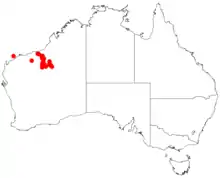Acacia robeorum
Acacia robeorum, commonly known as Robe's wattle,[1] is a shrub of the genus Acacia and the subgenus Phyllodineae that is endemic to north western Australia.
| Robe's wattle | |
|---|---|
| Scientific classification | |
| Kingdom: | Plantae |
| Clade: | Tracheophytes |
| Clade: | Angiosperms |
| Clade: | Eudicots |
| Clade: | Rosids |
| Order: | Fabales |
| Family: | Fabaceae |
| Clade: | Mimosoideae |
| Genus: | Acacia |
| Species: | A. robeorum |
| Binomial name | |
| Acacia robeorum | |
 | |
| Occurrence data from AVH | |
Description
The shrub typically grows to a height of 2 to 3 m (6 ft 7 in to 9 ft 10 in) and have a diffuse, spreading, openly branched and multi-stemmed habit. The main stems are usually slightly crooked and support an open croen with smooth grey coloured bark on the main stems that becomes a light bronze colour on the on upper branches. The terete and glabrous branchlets have yelloish to bronze coloured but obscure ribbing and spint stipules with a length of 1.5 to 4 mm (0.059 to 0.157 in) that are found less as the plants ages. Like mosr pecies of Acacia it has phyllodes rather than true leaves. The thick, fleshy and evergreen phyllodes have a linear to narrowly linear-oblanceolate shape with a length of 15 to 35 mm (0.59 to 1.38 in) and a width og 1 to 4 mm (0.039 to 0.157 in)and have an obscure midrib.[1]
Distribution
It is native to an area in the Kimberley and Pilbara regions of Western Australia.[2] The range of the shrub extends from around Marble Bar and Pardoo Station in the north of the Pilbara down to around Ethel Creek Station in the south and out to Rudall River National Park in the Little Sandy Desert where it is often situated along drainage lines growing in sandy loam or skeletal sandy soils over laterite, granite or quartz bedrock as a part of spinifex grassland communities.[1]
See also
References
- "Acacia robeorum". Wattles of the Pilbara. Department of Environment and Conservation. 2010. Retrieved 7 August 2020.
- "Acacia robeorum". FloraBase. Western Australian Government Department of Parks and Wildlife.